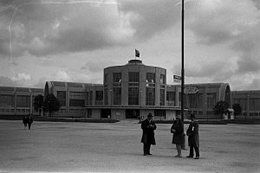
The Brno Exhibition Centre was opened 95 years ago by the Exhibition of Contemporary Culture
 |
The exhibition was intended to build on the successful Jubilee Exhibition held in 1891 in Prague, and it was patronized by the Czechoslovak president, Tomáš Garrigue Masaryk. Brno, which has a trade fair tradition dating back to the 18th century, was chosen as a compromise between Prague and Bratislava. The presentation received enthusiastic acceptance, and attendance at the event exceeded expectations. By mid-October 1928, approximately 2.7 million people had visited the exhibition, which ended with a gross profit of 16 million crowns.
However, the most successful "exhibit" was the exhibition center itself. The decision to build it was made in 1923 when land was purchased in the area of the current site. Construction in Brno - Pisárky began in December 1926. In a record time of 14 months, 69 pavilions and other buildings were erected on 36 hectares (with an exhibition area in the pavilions of 30,355 square meters). Landscaping was also completed, with the main avenues lined with already matured trees.
In the competition for the urban planning of the exhibition area, the design by Josef Kalouse won among 31 projects, featuring two radiating axes. Top Czech architects of the time, including Bohuslav Fuchs, Pavel Janák, Josef Gočár, Emil Králík, Jiří Kroha, and Kamil Roškot, contributed to his concept. This design applied functionalism to an unprecedented extent, and as a result, the exhibition center has retained an elegant and modern appearance alongside its functionality to this day.
The glory of the exhibition center gradually declined in the 1930s. By the end of the war, the site was largely destroyed due to bombing. There were discussions about its demolition and conversion into an amusement park. The importance of the site was revived by the growth of the economy and industry in the late 1950s. At the first International Engineering Fair (MSV) in 1959, visitors admired pavilions B, C, and especially the circular pavilion Z - the new landmark and symbol of the exhibition center. Since 1991, the site has been a cultural monument.
In 1960, the Foreign Trade Company Brno Trade Fairs and Exhibitions became the owner of the exhibition center. 31 years later, the company was privatized. Since 2001, the official name of the company has been Veletrhy Brno, a.s.; the abbreviation BVV from the original name has remained so well-known to the public that it continues to be used as a shortened name. Since 2016, the owner of Veletrhy Brno has been the city of Brno.
According to the BVV website, the exhibition center has a net exhibition area of 130,000 square meters and ranks among the largest exhibition centers in the world. In addition to trade fairs, congresses, conventions, balls, various sports events, and concerts are also held here. The development plan for the exhibition center is regularly updated, and among the most modern buildings at the exhibition center is pavilion P, opened in 2009, with an exhibition area of over 10,000 square meters. Approximately 50 trade fairs are held annually at the exhibition center, drawing nearly a million visitors. The most significant trade fair is the international engineering fair.
The English translation is powered by AI tool. Switch to Czech to view the original text source.
0 comments
add comment
Related articles
0
06.02.2020 | Brno Trade Fairs are profitable, they will build a new pavilion
0
04.09.2018 | Brno approved a shareholder loan of 350 million CZK to the Exhibition Grounds
0
23.05.2018 | The Brno Exhibition Center was opened 90 years ago by the Exhibition of Contemporary Culture
0
21.08.2017 | A hundred years since the founding of Czechoslovakia will be celebrated in Brno at the exhibition grounds
0
24.05.2017 | Brno will announce a two-round competition for the design of the exhibition grounds
0
12.04.2017 | The committee approves the study conditions for the appearance of the Brno Exhibition Centre
0
30.12.2015 | The management of the Brno Trade Fairs was surprised by DRFG's plans to transform the exhibition grounds
0
23.05.2013 | Brno will have the fairs appraised, continues negotiations for their purchase
1
23.05.2008 | The Brno Exhibition Centre was opened 80 years ago with an exhibition of contemporary culture










